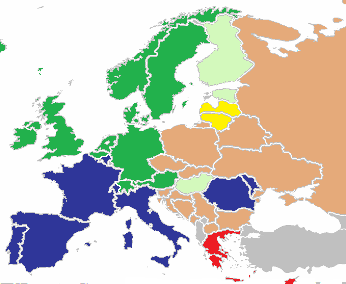European Languages family tree
European languages

European family tree (main language groups in Europe).
- Italic (Latin) - blue
- Germanic - green
- Slavic - brown
- Baltic - yellow
- Hellenic (Greek) - red
- Uralic - light green
Uses Latin script with no use of Russian cyrilic script at all.
European family tree
The actual title should be Indo-European language tree as Armenian and Indo-Iranian (Hindi, Farsi, Urdu, Kurdish, etc..) languages should be included. Within this European language tree, only main languages have been included, there are a lot of smaller regional languages that have not been included.
Finnish, Hungarian and Estonian belong to the Uralic (also called Finno-Ugric) family.
Italic (Latin)
Romance
- Catalan
- French
- Italian
- Occitan
- Portuguese
- Romanian
- Spanish
Romance languages
All languages in this group are derived from Latin. All are geographically in Western Europe and form the five main national languages: French, Spanish, Italian, Portuguese and Romanian.
The Romance languages are similar and share a lot of similar words, eg: French and Italian share 89% lexical similarity, as do Spanish and Portuguese. Spanish and Portuguese have borrowed from Arabic, French from Germanic, and Romanian from Slavic because of historical and geographical reasons.
French, Portuguese and Spanish generally use /s/ in the plural form, while the Italian and Romanian use vowels.
The two genders (masculine and feminine) are used by all the above languages.
Word order in the sentance is subject-verb-object. Adjectives follow after the noun and agree with it in gender and number.
In order of most amount of speakers: Mandarin Chinese, English, Hindi/Urdu, Russian, Spanish, Japanese, German, Indonesian and Portuguese.
English, French and Spanish in corresponding order are the main second languages learnt.
Germanic
North Germanic
West Germanic
Germanic languages
Dutch is the closest language to English, although English speakers will not see the similarity (written and spoken) as the two are not at all mutualy intelligible. Most Dutch, German and Scandinavians speak English fluently.
German is the most spoken second language (before English) in Eastern and Central Europe.
Word order in German is much more complicated because of the verb final position in subordinate clauses.
German is the least like the other languages in this group.
Scandinavian word order is similar to English
Swedish and Norwegian use different tones/pitches with accents so can sound very up and down when listening to it being spoken.
Slavic
Western
Eastern
Southern
Slavic languages
The Western Slavic languages (see the list above) use the Roman alphabet, while the Eastern Slavic languages (see above) use the Cyrillic alphabet.
Slavic languages are very similar to Lithuanian and Latvian (Baltic languages).
All Slavic languages use singular and plural, as well as three genders (masculine, feminine and neuter).
Baltic
Uralic
Finno-Ugric
Celtic
Brythonic
- Breton
- Welsh
Goidelic
- Irish
- Scottish (Gaelic)
Improvements to this site?
French script
Tous les êtres humains naissent libres et égaux en dignité et en droits. Ils sont doués de raison et de conscience et doivent agir les uns envers les autres dans un esprit de fraternité.
Danish script
Alle mennesker er født frie og lige i værdighed og rettigheder. De er udstyret med fornuft og samvittighed, og de bør handle mod hverandre i en broderskabets ånd.
Dutch script
Alle mensen worden vrij en gelijk in waardigheid en rechten geboren. Zij zijn begiftigd met verstand en geweten, en behoren zich jegens elkander in een geest van broederschap te gedragen.
Czech script
Všichni lidé se rodí svobodní a sobě rovní co do důstojnosti a práv. Jsou nadáni rozumem a svědomím a mají spolu jednat v duchu bratrství.
Belarusian script
Усе людзi нараджаюцца свабоднымi i роўнымi ў сваёй годнасцi i правах. Яны надзелены розумам i сумленнем i павiнны ставiцца адзiн да аднаго ў духу брацтва.
Bulgarian script
Bсички хора се раждат свободни и равни по достойнство и права. Tе са надарени с разум и съвест и следва да се отнасят помежду си в дух на братство.
Latvian script
Visi cilveki piedzimst brivi un vienlidzigi sava pašciena un tiesibas. Vini ir apveltiti ar sapratu un sirdsapzinu, un viniem jaizturas citam pret citu bralibas gara.
Estonian script
Kõik inimesed sünnivad vabadena ja võrdsetena oma väärikuselt ja õigustelt. Neile on antud mõistus ja südametunnistus ja nende suhtumist üksteisesse peab kandma vendluse vaim.
Breton script
Dieub ha par en o dellezegezh hag o gwirioù eo ganet an holl dud. Poell ha skiant zo dezho ha dleout a reont bevañ an eil gant egile en ur spered a genvreudeuriezh.